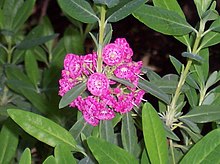Kalmia angustifolia is a flowering shrub in the family Ericaceae, commonly known as sheep laurel. It is distributed in eastern North America from Ontario and Quebec south to Virginia.[1] It grows commonly in dry habitats in the boreal forest, and may become dominant over large areas after fire or logging.[2] Like many plant species of infertile habitats it has evergreen leaves and mycorrhizal associations with fungi.[3] It is also found in drier areas of peat bogs.
| Sheep-laurel | |
|---|---|

| |
| Scientific classification | |
| Kingdom: | Plantae |
| Clade: | Tracheophytes |
| Clade: | Angiosperms |
| Clade: | Eudicots |
| Clade: | Asterids |
| Order: | Ericales |
| Family: | Ericaceae |
| Genus: | Kalmia |
| Species: | K. angustifolia
|
| Binomial name | |
| Kalmia angustifolia | |

Description
editThe attractive, small, deep crimson-pink flowers are produced in early summer. Each has five sepals, with a corolla of five fused petals, and ten stamens fused to the corolla. They are pollinated by bumblebees and solitary bees. Each mature capsule contains about 180 seeds.[4]
In the wild the plant may vary in height from 15–90 cm (6–35 in). New shoots arise from dormant buds on buried rhizomes. This process is stimulated by fire.[4] The narrow evergreen leaves, pale on the underside, have a tendency to emerge from the stem in groups of three. The Latin specific epithet angustifolia means "narrow-leaved".[5] A peculiarity of the plant is that clusters of leaves usually terminate the woody stem, for the flowers grow in whorls or in clusters below the stem apex.[6]
Cultivation
editKalmia angustifolia is cultivated as an ornamental garden shrub. It prefers a moist, acidic soil in partial shade. The species has gained the Royal Horticultural Society's Award of Garden Merit.[7] Numerous cultivars have been selected for garden use, of which K. angustifolia f. rubra,[8] with rich red flowers, has also won the award.[9]
Toxicity
editKalmia contains a glycoside, known as andromedotoxin.[10] It is poisonous to mammals. Hence, it can be unwelcome in pastures.[11] Several of its folk-names testify to the plant's toxicity: 'lamb-kill', 'sheep kill', 'calf-kill', 'pig laurel', 'sheep-laurel' and 'sheep-poison'.[12] It is also known as narrow-leaved laurel and dwarf laurel.[12]
References
edit- ^ "USDA Plants Database".
- ^ Weetman, G. F. 1983. Forestry practices and stress on Canadian forest land. pp. 260–301. In W. Simpson-Lewis, R. McKechnie, and V. Neimanis (eds.) Stress on Land in Canada. Ottawa: Lands Directorate, Environment Canada.
- ^ Keddy, P.A. 2007. Plants and Vegetation: Origins, Processes, Consequences.Cambridge University Press, Cambridge, UK. 666 p.
- ^ a b Hall, I. V., Jackson, L. P. and Everett, C. F. 1973. The biology of Canadian weeds. 1. Kalmia angustifolia L. Canadian Journal of Plant Science 53: 865–873.
- ^ Harrison, Lorraine (2012). RHS Latin for Gardeners. United Kingdom: Mitchell Beazley. ISBN 978-1845337315.
- ^ Blanchan, Neltje. 1917. Wild Flowers Worth Knowing Doubleday, New York.Project Gutenberg Literary Archive Foundation
- ^ "Kalmia angustifolia". www.rhs.org. Royal Horticultural Society. Retrieved 12 February 2020.
- ^ "RHS Plant Selector - Kalmia angustifolia f. rubra". Royal Horticultural Society. Retrieved 12 February 2020.
- ^ "AGM Plants - Ornamental" (PDF). Royal Horticultural Society. July 2017. p. 57. Retrieved 14 March 2018.
- ^ "Kalmia angustifolia, K. carolina". plants.ces.ncsu.edu. Archived from the original on 2019-05-03. Retrieved 2019-02-01.
- ^ "Kalmia angustifolia". www.fs.fed.us. Retrieved 2019-02-01.
- ^ a b "Kalmia angustifolia". Germplasm Resources Information Network. Agricultural Research Service, United States Department of Agriculture. Retrieved 24 December 2017.
Media related to Kalmia angustifolia at Wikimedia Commons